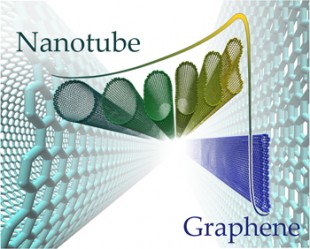A study carried out at the Richard E. Smalley Institute for Nanoscale Science and Technology, Rice University, revealed the potential of flattened carbon nanotubes.
 Flattened nanotubes (Credit: Ksenia Bets/Rice University)
Flattened nanotubes (Credit: Ksenia Bets/Rice University)
Labeled as closed-edged graphene nanoribbons, they are the result of carbon nanotubes collapsing during growth. The nanoribbons demonstrate the properties of both graphene ribbons and nanotubes and hence could have a host of applications in the fields of materials and electronics. Collapsed nanotubes have the chemistry of both graphene in the middle and carbon-60 molecules (buckyballs) on the sides.
Researchers led by Robert Hauge found that the two portions can be separated by addition of functional groups on the sides. With the sides acting as insulators, the top and bottom layers are isolated and do not interact with the exception of excited-state or van der Waals-type interaction. Hauge believes that it is this process that generates new electronic and physical properties.
Slicing graphene has never yielded ribbons with well-defined sides which has an impact on the properties. The new finding paves the way for perfect edged two or four layered graphene. The team was able to find collapsed nanotubes through a transmission electron microscope and measure them using an atomic force microscope. But the cause for the collapse was determined only after a collaborative study with physicist Boris Yakobson’s team. The results of this study showed that growing nanotubes at a temperature of 750°C was conducive for pushing atoms on either sides of the inner wall closer which subsequently sets off a van der Walls tumble that leads to nanotube collapse.
The findings showed that the energy required for pressing a nanotube decreases with increase in tube diameter. The team also determined the diameter at which tubes become susceptible to collapse. It was found to be 2.6 nm for single-walled tubes and 4 nm for double-walled tubes. This state of susceptibility to collapse is known as energy equivalence point and is a fight between the central van der Walls force and strain energy on the edges. While the discovery could facilitate future applications of nanotubes as fibers in electrical devices, Hauge believes there are still unanswered questions such as energy performance in comparison with conventional hexagonal structured tubes, the effect of atomic arrangement on collapsing and the magnitude of the collapse.